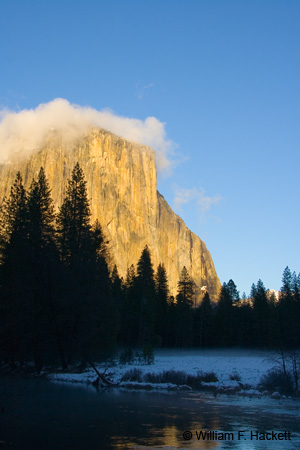El Capitan

El Capitan, one of the prominent features of Yosemite Valley in Yosemite National Park, is a 3000-foot (910-m) vertical granite monolith on the north side of the valley, near the western end. The feature is the second highest unbroken cliff in the world, after Mount Thor on Baffin Island in the Canadian Arctic. El Capitan is one of the world’s favorite challenges for rock climbers.
El Capitan consists almost completely of El Capitan granite, a coarse-grained pale granite that was emplaced about 100 million years ago. This type of granite forms most of the features of western Yosemite Valley. The uppermost part of the cliff face is formed of a separate intrusion of igneous rock, Taft Granite. Another igneous rock, diorite, forms dark intrusions through both kinds of granite.
Glacial action carved El Capitan, and most of the sculpting of El Capitan is believed to result from the Sherwin Glaciation of about 1.3 to 1 million years ago. Since the rock face of El Capitan is relatively free from joints, the surface was not eroded as much as other, more jointed, rock features nearby.
The rock formation was named El Capitan by the Mariposa Battalion (1) when it explored Yosemite Valley in 1851. El Capitan (“the captain,” “the chief”) is believed to be a Spanish Translation of the Native American name that has been transcribed as “To-to-kon oo-lah” or “To-tock-ah-noo-lah.” Whether the name refers to a particular tribal chief, or simply “the chief” or “rock chief” is unknown.
The top of El Capitan can be reached by hiking out of Yosemite Valley on the trail next to Yosemite Falls, and then traveling west. For climbers ascending the sheer granite face of El Capitan, there are dozens of named routes, all long and difficult.
Once El Capitan was believed to be impossible to climb. Today, El Capitan is considered the standard for “Big-Wall Climbing.” El Capitan has two main faces for climbing, the southwest and the southeast face. Between these faces is a massive prow. The most popular and historically famous route is “The Nose,” which follows the massive prow, and which was first climbed in 1958 by Warren J. Harding, Wayne Merry, and George Whitmore in 47 days using “siege” techniques. A history of climbing El Capitan is summarized in the Wikipedia article, including a free-climbing ascent of “The Nose” in 12 hours by Tommy Caldwell and the speed climbing of the nose using “aid techniques” by the brothers, Alexander and Thomas Huber, in 2 hours, 45 minutes, and 45 seconds.
El Capitan has a controversial history concerning the practice of BASE jumping. The National Park Service has effectively banned the practice. Michael Pelkey and Brian Schubert, two skydivers from Barstow, California, made the first BASE jump from El Capitan on July 24, 1966, and both men broke bones during the jump. The National Park Service experimented with issuing permits for a few months in 1980. During this time, legal jumps resulted in no major injuries. Since some jumpers showed disregard for the park’s rules and the environment, the National Park Service stopped issuing permits. On October 23, 1999, stuntwoman Jan Davis died while making an illegal BASE jump in support of lifting the park’s ban. BASE jumpers continue to pursue the lifting of the ban through legal action.
As you can see from links to my photos in the text above, one of the fascinating things about El Capitan to a photographer is how the granite monolith changes in appearance (even hourly), mirroring the weather, lighting, and atmospheric conditions, and in winter, even serving as a place for clouds to rest. One year, I got a totally new perspective (for me) on El Capitan with this photograph of the “backside” of El Capitan from what is normally the middle of the Merced River. Sometimes, in October and November of years with little precipitation, places in the Merced River can be reduced to a series of sand bars, and even the mighty Yosemite Falls, to a wet face of rock. With current drought conditions (for the last two winters), this year may be one of those years.
-Bill at Cheshire Cat Photo™
You can view higher-resolution photos (*generally* 7-30 megabytes, compressed) at the Cheshire Cat Photo™ Pro Gallery on Shutterfly™, where you can also order prints and gifts decorated with the photos of your choice from the gallery. Apparel and other gifts decorated with some of our most popular photos can be ordered from the Cheshire Cat Photo™ Store on CafePress®. Both Shutterfly™ and CafePress® ship to most international locations worldwide!







